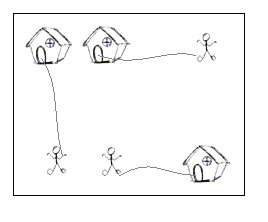Going Home
| Time Limit: 1000MS | Memory Limit: 65536K | |
| Total Submissions: 15944 | Accepted: 8167 |
Description
On a grid map there are n little men and n houses. In each unit time, every little man can move one unit step, either horizontally, or vertically, to an adjacent point. For each little man, you need to pay a $1 travel fee for every step he moves, until he enters a house. The task is complicated with the restriction that each house can accommodate only one little man.
Your task is to compute the minimum amount of money you need to pay in order to send these n little men into those n different houses. The input is a map of the scenario, a '.' means an empty space, an 'H' represents a house on that point, and am 'm' indicates there is a little man on that point.

You can think of each point on the grid map as a quite large square, so it can hold n little men at the same time; also, it is okay if a little man steps on a grid with a house without entering that house.
Your task is to compute the minimum amount of money you need to pay in order to send these n little men into those n different houses. The input is a map of the scenario, a '.' means an empty space, an 'H' represents a house on that point, and am 'm' indicates there is a little man on that point.

You can think of each point on the grid map as a quite large square, so it can hold n little men at the same time; also, it is okay if a little man steps on a grid with a house without entering that house.
Input
There are one or more test cases in the input. Each case starts with a line giving two integers N and M, where N is the number of rows of the map, and M is the number of columns. The rest of the input will be N lines describing the map. You may assume both N and M are between 2 and 100, inclusive. There will be the same number of 'H's and 'm's on the map; and there will be at most 100 houses. Input will terminate with 0 0 for N and M.
Output
For each test case, output one line with the single integer, which is the minimum amount, in dollars, you need to pay.
Sample Input
2 2 .m H. 5 5 HH..m ..... ..... ..... mm..H 7 8 ...H.... ...H.... ...H.... mmmHmmmm ...H.... ...H.... ...H.... 0 0
Sample Output
2 10 28
Source
题意:
给定一个N*M的地图,地图上有若干个man和house,且man与house的数量一致。man每移动一格需花费$1(即单位费用=单位距离),一间house只能入住一个man。现在要求所有的man都入住house,求最小费用。
man可以从house上跨过
思路:
模板题 建图之后 直接套最小费用流模板
#include <stdio.h>
#include <iostream>
#include <string.h>
#include<cmath>
using namespace std;
const int N=300;
const int MAXE=200000;
const int inf=1<<30;
int head[N],ep;
int d[N],pre[N];
bool vis[N];
int q[MAXE];
struct Edge
{
int u,v,c,w,next;
}edge[MAXE];
void addedge(int u,int v,int w,int c)//u v 费用 容量
{
edge[ep].u=u;
edge[ep].v=v;
edge[ep].w=w;
edge[ep].c=c;
edge[ep].next=head[u];
head[u]=ep++;
edge[ep].v=u;
edge[ep].u=v;
edge[ep].w=-w;
edge[ep].c=0;
edge[ep].next=head[v];
head[v]=ep++;
}
int SPFA(int src,int des)
{
int l,r;
memset(pre,-1,sizeof(pre));
memset(vis,0,sizeof(vis));
for(int i=0;i<=des;i++) d[i]=inf;
d[src]=0;
l=0;r=0;
q[r++]=src;
vis[src]=1;
while(l<r)
{
int u=q[l++];
vis[u]=0;
for(int j=head[u];j!=-1;j=edge[j].next)
{
int v=edge[j].v;
if(edge[j].c>0&&d[u]+edge[j].w<d[v])
{
d[v]=d[u]+edge[j].w;
pre[v]=j;
if(!vis[v])
{
vis[v]=1;
q[r++]=v;
}
}
}
}
if(d[des]==inf)
return 0;
return 1;
}
int MCMF(int src,int des)
{
int flow=0,ans=0;//flow是得到的最大流的值 ans得到的是最小的费用
while(SPFA(src,des))
{
ans+=d[des];
int u=des;
int mini=inf;
while(u!=src)
{
if(edge[pre[u]].c<mini)
mini=edge[pre[u]].c;
u=edge[pre[u]].u;
}
flow+=mini;
u=des;
while(u!=src)
{
edge[pre[u]].c-=mini;
edge[pre[u]^1].c+=mini;
u=edge[pre[u]].u;
}
}
return ans;
}
///以上为模板
struct man
{
int x;
int y;
}M[111];
struct house
{
int x,y;
}H[111];
char str[111];
int main()
{
int n,m,mcnt,hcnt,i,j,src,des;
while(scanf("%d%d",&n,&m)!=EOF)
{
if(!n&&!m) break;
ep=0;
memset(head,-1,sizeof(head));
mcnt=hcnt=0;
for(i=0;i<n;i++)
{
scanf("%s",str);
for(j=0;j<m;j++)
{
if(str[j]=='H')
{
hcnt++;
H[hcnt].x=i; H[hcnt].y=j;
}
else if(str[j]=='m')
{
mcnt++;
M[mcnt].x=i; M[mcnt].y=j;
}
}
}
for(i=1;i<=mcnt;i++)
{
for(j=1;j<=hcnt;j++)
{
int dis=abs(M[i].x-H[j].x)+abs(M[i].y-H[j].y);
addedge(i,mcnt+j,dis,1);
//addedge(mcnt+j,i,dis,1);
}
}
src=0;
des=mcnt+hcnt+1;
for(i=1;i<=mcnt;i++)
addedge(src,i,0,1);
for(j=1;j<=hcnt;j++)
addedge(mcnt+j,des,0,1);
int ans=MCMF(src,des);
printf("%d\n",ans);
}
return 0;
}










 本文深入探讨了游戏开发领域的核心技术,包括游戏引擎、动画、3D空间视频等关键概念及其实现方法,旨在帮助开发者提升游戏开发技能。
本文深入探讨了游戏开发领域的核心技术,包括游戏引擎、动画、3D空间视频等关键概念及其实现方法,旨在帮助开发者提升游戏开发技能。
















 1883
1883

 被折叠的 条评论
为什么被折叠?
被折叠的 条评论
为什么被折叠?








